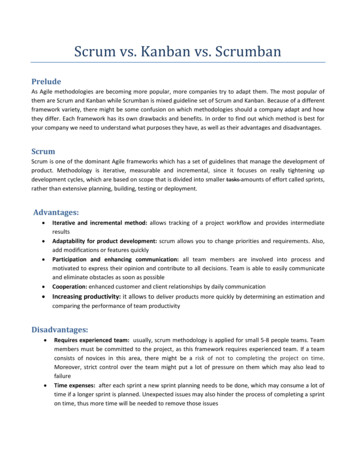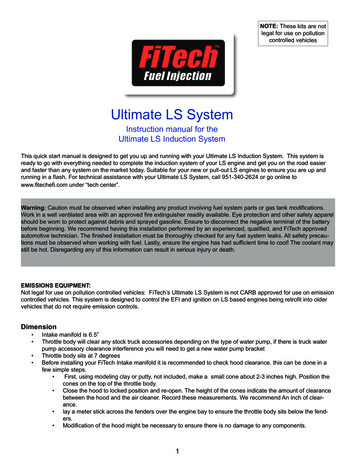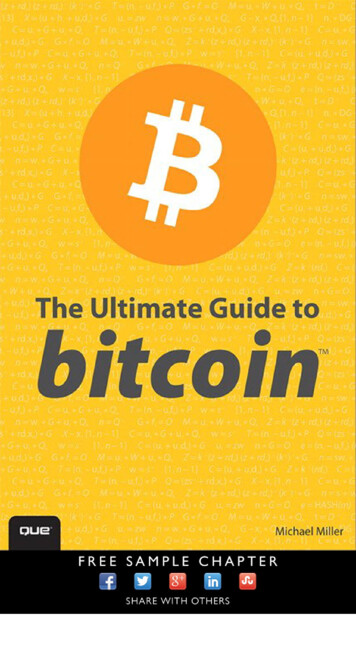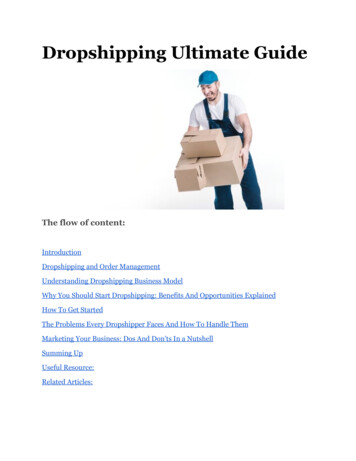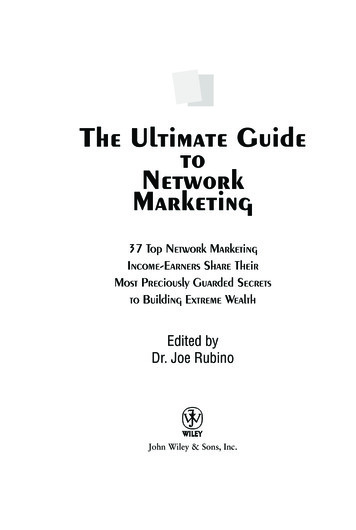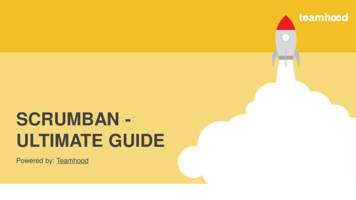
Transcription
SCRUMBAN ULTIMATE GUIDEPowered by: Teamhood
What isScrumban?Scrumban is an Agile framework that helps teamsmanage projects more efficiently.Scrumban was created by mixing two other popular Agileframeworks Scrum and Kanban. Initially, it was used as astepping stone when switching from one of the parentframeworks to the other. However, in time teams startedseeing value in Scrumban and it became a standalonepractice.
Why Scrumban?Easier to adopt than Scrum010203Scrumban has a less constrained process,more similar to Kanban. Thus, the teams canlearn and pick it up faster.Great for R&D teams and productdevelopmentThe quick paced process allows to test outideas quickly and without much loss.Focused on throughput andcontinuous improvement Scrumban ensures the team produces at asteady pace and keeps improving their process.
Key aspects of Scrumban1. Planning & planning trigger The team plans only for nextSprint and only when needed.4. Work freeze and TriageHelps identify and execute the mostimportant work items at the end.2. Kanban board For visualizing and tracking workitems throughout the process.3. WIP Limit Limits the number of tasks theteam can work on at a time.5. Planning buckets 5Aids the Scrumban team in longterm planning efforts.
1. Planning and planning triggerIn Scrumban the team plans for the next Sprint only. This is done basedon previous performance and estimation.To know when to plan for the next iteration Scrumban teams use a planningtrigger. This is a number that defines how many tasks should be left in thebacklog when the team holds a planning session.For example, a team of 5 people have an average cycle time of 1 day and ittakes 2 days for them to hold a planning session. To make sure there are nointerruptions in the process, they have to hold the planning session at a timewhere the team still has 2 days of work left in the backlog. So their planningtrigger is 10.
2. Kanban boardTo monitor the work that is being done, Scrumban teams use a Kanbanboard. This allows them to track all the work that is planned, being doneand completed.Kanban boards vary from team to team, but usually are composed out ofBacklog, Process section (divided into columns based on your process –Design, Manufacturing, etc.) and Done column.It is important to note, that the team members pull tasks from thebacklog on their own. Once a team member is done with a task, theyreview the backlog and pick the highest priority task based on their skillset.This is why it is important to review the board daily and reprioritize if needed.
53. WIP limitsTo ensure constant value delivery, Scrumban teams limit the amount ofwork items the team can work on at any given time. This is called aWork In Progress (WIP) limit.It helps deliver each individual work item faster and allows to more easilyestimate the delivery dates of all work items.Usually the teams set this limit based on the amount of people in the team.For example, if there are 5 people in the team the WIP limit is 5. Thus, eachteam member can work on one task at a time.
4. Work freeze and triageTo control the work scope at the end of the project, Scrumban teamsuse Work freeze and Triage.First a Work freeze is used, meaning the team cannot add any new tasks tothe backlog. Then, the project manager or the team implements the Triage.Which means they look through the backlog and decide which of the tasksthey are going to complete and which will be left undone in this cycle.These measures help ensure the team delivers a minimum viable product atthe end of each sprint throughout the project.
5. Planning bucketsPlanning buckets are the long-term planning technique that Scrumbanteams use.It works by specifying 3 buckets (this can be lists or simply additionalcolumns in a Kanban board) where the team lists out their roadmap. The first bucket holds the largest ideas and goals that the team wants torealize within a year. The second bucket holds clearer plans that the team wants to realizewithin 6 months. And the third bucket holds specific plans for the next 3 months.As the team decides to move forth with their plans, they are moved to thebacklog and executed in the next iteration.
ScrumbanTeam rolesScrumban does not specify any roles for theteams to use. Instead, the teams are encouragedto keep the roles they used previously andchange them up only if necessary.One thing to note when assembling a Scrumban team is tomake sure they are self-managing. As many processes areleft for the team to handle without having a project manager.
Scrumban cycleThe Scrumban cycle usually follows these 6 steps that are repeated during every Sprint throughout the project.Work item refinement Retrospective Planning Release Daily standupWork freeze , Triage &Stabilization
1Work item refinement23456Work item refinement takes place before every Sprintand is aimed to identify which of the work itemsshould be considered for the next iteration.This meeting is attended by the project manager and thestakeholders, and it helps set the direction in which theteam will be going next. It is important to consider whichof the suggested work items are the most important andwhy.Once you have a prioritized list, you also have to definewhat has to be done for each of those items. So that oncethe team gathers for a planning session they can pick upthe work items and start working on them without anyissues.
1Planning23456Once the project begins and then each time after theplanning trigger goes off, the Scrumban team meets toplan tasks for their next Sprint.The team takes the most important work items from therefined product backlog, specify what has to be done foreach and estimate how much time that is going to take.The team only takes so many tasks that they can completein one Sprint.
1Daily standup23456The team then starts working on the planned tasks.Each team member pulling tasks from the backlogbased on their priority.To make sure tasks are completed quickly, no teammember can work on more than one task at a time. And totrack the progress and identify issues, the team gatherseach day to review their progress in a short standup meeting.
123456Work freeze, Triage &StabilizationIf the team is working with time boxed Sprints or the projectis coming to an end, the project manager might use a Work freeze. This means that the team can no longer take onnew tasks from the backlog.Then the project manager holds a Triage and decideswhich of the backlog items the team is going to complete inthe current Sprint or project, and which of them will be leftunfinished.Work freeze and triage mean that the amount of workcompleted by the team will stop growing and stabilize.
1Release2345Once the team reaches the deadline or completes allthe planned tasks, the Sprint ends. The goal of theteam is to make an incremental change to the endproduct during the Sprint and then present it to thestakeholders during the Release.Here, the project manager or the team representativeexplains what has been done and gathers feedback fromthe client. This way checking if they like where the team isgoing and gather any new requirements.This allows the Scrumban team to adjust course andpresent the best result for the clients.6
1Retrospective2The final step of the Scrumban process is theRetrospective.3456After every release, the team gathers to review their workprocesses and to identify what went well and what needsimprovements for the next cycle. This is a good place toimplement process changes and to commit to 1 or 2concrete improvements for the next Sprint.Once the Retrospective is done, the cycle begins againfrom the first step.
Scrumban board example
Scrumban board example
ScrumKanbanScrumbanIterations1-4 week sprintsContinuous work alongside shorter releasesWork routinesPull principle, late binding to team membersScope limitsPlanning routinesPush and pull principles, early binding to team membersSprint limits total work amountSprint planningContinuous work with short planning cycles& longer release cyclesPull principle, late binding to team membersWork in progress limitsRelease/iteration planning, demand planningWork in progress limitsPlanning on demand for new tasksEstimationPerformance metricsMust be done before a sprintBurndownOptionalCumulative flow diagram, lead & cycle timeOptionalAverage cycle timeContinuousimprovementMeetingsTeam membersSprint retrospectiveOptionalShort Kaizen event as an optionSprint planning, daily scrum, retrospectiveCross-functional team membersShort Kaizen eventSpecialization or preference to tasksTask sizeNew items in iterationNot bigger than a SprintForbiddenCan be avoidedCross-functional team members,specialization is allowedAny sizeAllowed whenever queue allows itOwnershipOwned by a teamSupports multiple teams ownershipSupports multiple teams ownershipBoardPrioritizationRolesRulesFit forDefined/reset each sprintThrough backlogScrum master, product owner, teamConstrained processPersistentOptionalNot defined, may varyOnly a few constraints, flexible processPersistentRecommended on each planningNot defined, may varySlightly constrained processTeams working on product or projectwhich is longer than a yearSupport and maintenance teams,continuous product manufacturingStartups, fast-pace projects,continuous product manufacturingAny sizeAllowed whenever queue allows it
Thank youFor more information on Agile, visit:www.teamhood.com
2. Kanban board To monitor the work that is being done, Scrumban teams use a Kanban board. This allows them to track all the work that is planned, being done and completed. Kanban boards vary from team to team, but usually are composed out of Backlog, Proc
